Section II: 1940’s – 1980’s
Microwaves and Vacuum Tubes to Solid-State Devices
The lab closest to Dow’s own area of specialty was the Electron Tube Lab, established in 1946 with funding from the U.S. Army Signal Corps. The Corps sponsored research into the behavior of microwave magnetron oscillators, which resulted in well-equipped microwave measurement and electron tube laboratories in the new East Engineering addition. Faculty in the lab made significant contributions to research in microwave tubes, including magnetrons, traveling-wave tubes, backward-wave oscillators and crossed-field amplifiers.
In the early 1950’s, Joseph E. Rowe (BSE MSE PhD EE ’51 ’52 ’55; and BSE Math ’51) developed important new theory regarding traveling-wave amplifiers, and developed the Crestatron, a new type of high-efficiency, high-power microwave amplifier. Rowe and others later developed a Poisson cell and analog computer system for the design of electron injection systems. That system was installed at the U.S. Army Electronics Command Laboratories.

When Rowe became lab director in 1958, the lab was renamed Electron Physics Laboratory (EPL). Research focused on microwave electron tube devices, gaseous plasmas, and semiconductors. Under his leadership, the Electron Physics Laboratory became one of the premier laboratories on campus; it was the forerunner of the Solid-State Electronics Laboratory.
Rowe was one of the major pioneers in the area of microwave devices and, in particular, vacuum tube devices such as traveling wave tubes and magnetrons. These devices are still in wide use today in many applications, including high-power communication and radar systems as well as microwave ovens. His 1965 book, Nonlinear Electron Wave Interaction Phenomena, became a standard in the field. He left the University in 1974 to become Dean of Engineering and then Provost of Case Western Reserve University. He was elected a member of the National Academy of Engineering in 1977 for “contributions to the theory and design of high-power microwave electron tubes and solid-state microwave devices.”
George Haddad (BSE MSE PhD EE ’56 ’58 ’63), Robert J. Hiller Professor, was named lab director when Rowe became the department chair in 1968. He developed the first X-band traveling-wave ladder line ruby MASER (Microwave Amplification by Stimulated Emission of Radiation), which was a forerunner of the modern laser. He worked for a time with Prof. Chihiro Kikuchi at Michigan, who invented the ruby maser. Kikuchi was hired in 1955 as an associate research physicist with the Willow Run Laboratories and became Head of the Solid State Physics Group in 1958. The MASER was one of the most significant solid-state devices of the time, and remains an important element in the amplification of microwave signals. One of Haddad’s early projects was to work on a cavity MASER that was placed on Peach Mountain to receive signals from outer space.
During these years, Prof. Haddad also advanced the state of the art of Impact Avalanche Transit Time (IMPATT), BARITT, and Gunn self-oscillating mixers for Doppler radar applications, microwave sensors, automotive radars, intrusion alarms, and door openers.
Prof. Haddad led the transition from microwave tubes to solid-state electronics, and Michigan has remained a leader in solid-state devices and integrated circuits ever since. He was named a member of the National Academy of Engineering, “For contributions to microwave electronics and for leadership in electrical engineering research and education.”
The first formal instruction in semiconductor electronics at Michigan occurred during the summer of 1950. This is an area of study that is now core to electrical engineering. By 1970, semiconductors had been introduced in all electronics courses offered by the Department, and there were a number of new courses in solid-state physics and integrated circuits.
Establishing the future of Systems
The current major area known as Systems in the department is comprised of three primary areas: Signal and Image Processing, Control Systems, and Communications. These areas include Information Theory, Computer Vision, Robotics, Embedded Systems, and Power. After the advent of sponsored research following WWII, Systems can be traced to three areas of activity in the department, with much overlap between them as well as other areas in EE.
Communications and Signal Processing
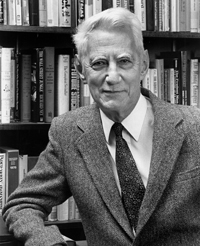
Father of Information Theory
In 1948, alumnus Claude Shannon published his landmark paper, “A Mathematical Theory of Communication,” which earned him the title, “Father of Information Theory.” [read about the U-M Shannon Centennial, held in 2016 to commemorate the date of Shannon’s birth]
Prof. Gunnar Hok was instrumental in introducing information theory instruction to the department. Hok was at the Harvard Radio Research Laboratory the same years as William Gould Dow (1944-45), and joined the department at Michigan two years later.
In 1951, Prof. Dow secured a major contract with the U.S. Army Signal Corps to investigate communication countermeasures for military objectives. The unit was called the Electronic Defense Group (EDG), and after a year or so became housed in the newly-built Cooley Memorial Building on North Campus. The research conducted in the EDG was basically electronic communications and signal processing. Dow directed the lab until 1953, when he became department chair. Hansford W. Farris was appointed director of the lab in 1958, after a series of directors who left to join industry or take academic promotions elsewhere. After he stepped down in 1961 to become department chair, Ben F. Barton served as chair until 1965, when he stepped down to serve as a Technical Advisor to NATO in Paris, France.

The Group was renamed the Cooley Electronics Laboratory in 1960 to reflect a growing diversity of research work, including: acoustic-optics, communications, information processes, instrumentation, solid-state circuits, and industrial sciences. As of 1970, the lab had 18 years of continuous funding, and graduated 37 PhD students. Several companies spun-off from the lab, including G.C. Optronics, JoDon Associates, Transidyne Corporation, and Balance Technology, Inc.
Over the years, a few groups within the lab grew large enough to form their own organizations. Among these were the Sensory Intelligence Group under Professor Wilson P. Tanner (an expert in Information Theory), and the Systems Engineering Group under Professors Arch W. Naylor (PhD EE ’60; expert in information and control engineering) and Keki B. Irani (MSE PhD EE ’49 ’53, expert in control theory, computer display and communication systems, and computer architecture).
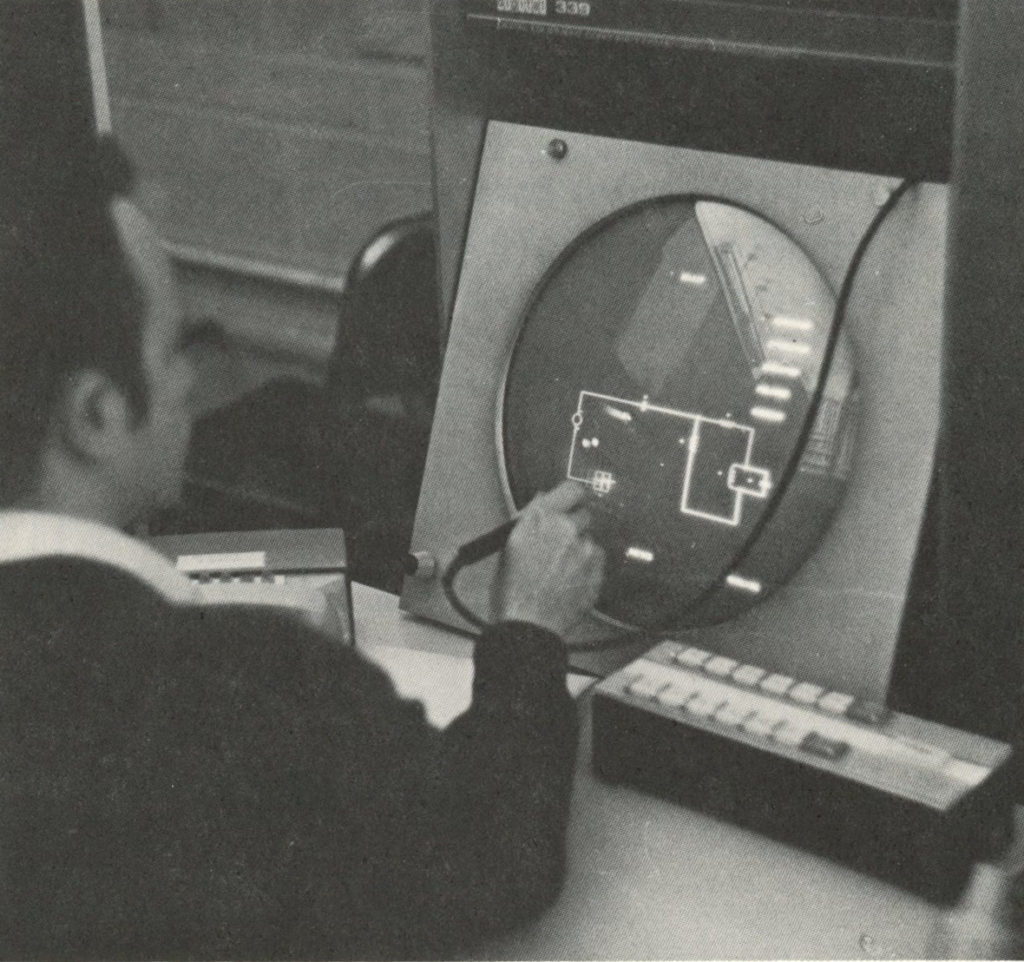
A formal Systems Engineering Lab was named in 1965, and included the fields of automatic control, communications, computers, and information and energy systems. The same year, the Sensory Intelligence Group was moved to the Psychology Department.
Following are some of the early chairs of the Systems Engineering Lab (a position that rotated each year):
- Norman Scott (who taught the first EE course in computers, and became known nationally for his work on digital computer logic and design),
- Arch Naylor, (helped introduce the developing field of information and control engineering at Michigan),
- Donald Calahan (expert in circuit theory, CAD, and large-scale computation), and
- John Meyer (expert in fault-tolerant computing), director of the lab from 1971-72 and 1980-81.
Ted Birdsall (BS MS Math 1950 1952; PhD CS 1966) was director of both the Cooley Electronics Laboratory and later the Communications and Signal Processing Laboratory. He received the Silver Medal in Signal Processing in Acoustics by the Acoustical Society of America, “for contributions to signal detection theory and development of coded sequences in underwater acoustics.” He is only the second recipient of this award.
Prof. Birdsall established an international reputation in the field of signal detectability theory. His work was relevant to sensory psychology, psychometrics, and underwater acoustics, and he often helped other researchers apply signal processing theory to their own fields of research. He is credited by some with co-inventing the receiver operating characteristic (ROC) curve. During the 1990’s, Prof. Birdsall was involved with an international consortium working on global warming initiatives. His work with the consortium on the use of underwater acoustics as a means of estimating changes in the average temperature of the oceans was described by the National Academy of Science as a remarkable achievement.
While in East Engineering, the lab maintained analog and digital computer facilities for research and instruction. The research of the Systems Laboratory that focused more on computer circuits spun out to become the Advanced Computer Architecture Laboratory in 1985. This lab was affiliated with the Computer Science and Engineering division in the newly formed EECS Department.
Control, Information, Computers – convergence and divergence
Control Engineering as an academic discipline came into its own following WWII. Up to that time, control was largely applied to the electric circuits found in telegraphy and telephony, as well as the electric power industry.
During the war, it was a time-consuming process to determine where an aircraft might be in order to fire anti-aircraft weapons. Automating the process became a focus of the National Defense Research Committee in 1940, in particular the section devoted to Detection, Controls and Instruments.
At Michigan, Prof. James S. Gault (BSE EE 1921) did important work in servomechanisms, an automatic device used in both military applications and in the electrical power industry. He taught the subject to servicemen during WWII, and later expanded the applications to the use of electric, hydraulic, and pneumatic elements to govern the flow of energy.
The servomechanism course was expanded and offered to graduate students. Since 1950, multiple loop and nonlinear systems were added and offered by Prof. Louis Kazda.
Throughout the country at this time, it was not unusual for Control to be taught in mechanical and aerospace engineering departments, as well as in electrical engineering. The same was true at Michigan. In fact, a graduate program closely associated with Control (of instruments) was created in 1953, called Instrumentation Engineering. In the beginning, the program was most closely affiliated with the Aerospace Department.
The first chair of Instrumentation Engineering was Lawrence L. Rauch, who joined the Department of Aeronautical Engineering in 1949. He would later serve as Acting Chair of the Electrical and Computer Engineering Department in 1972. During his early career at Michigan he created a number of new graduate courses in nonlinear systems, radio telemetry, instrumentation, and control systems.
The Instrumentation Engineering program broadened in scope and later became known as Information and Control Engineering. In 1968, the program was stretched again to include computers and became the Computer, Information and Control Engineering (CICE) Program (which is how this program will be referred to from here on). By this time, the program was most closely affiliated with Electrical and Computer Engineering, Aerospace Engineering, Mechanical Engineering, and Industrial and Operations Engineering. It was designed as a concentrated graduate program for students studying automatic control theory and communications theory, as well as digital computation.
Frederick J. Beutler joined the EE Department in 1957. He chaired the interdepartmental graduate programs that preceded and then included CICE for eleven years. His specialty was stochastic process theory and other mathematical tools for telecommunications.
The CICE program grew to well over a hundred students with 43 affiliated faculty from five different departments, and a curriculum of almost seventy courses over the course of the next decade. The legacy that individuals in the CICE program left in the field of Systems and Control Engineering is tremendous. In fact, two current faculty, Jessy Gizzle and Jeff Fessler, have taken the names of CICE faculty as their named professorship titles, Elmer G. Gilbert and William L. Root. Gilbert was a Michigan educated man, earning his B.S.E. and M.S.E degrees in electrical engineering, and Ph.D. in Instrumentation Engineering before joining the Aeronautical Engineering Department. In control theory, he is well known for the “Gilbert realization,” and he developed the foundational results for control over a moving horizon, which underlies model predictive control (MPC). On the hardware side, he was a key member of the design group responsible for the conception and development of analog hybrid computer systems, and an inventor of high performance computer devices. Root, a well-known pioneer in statistical communication and information theory, received the Claude E. Shannon Award in 1986. He became officially affiliated with the EECS Department that same year.
Arch Naylor joined the EE Department in 1960, and was affiliated early on with the Cooley Electronics Laboratory. He helped introduce the developing field of information and control engineering at the University, and was co-author of the textbook, Linear Operator Theory in Engineering and Science (1971). One of his students, Michael Stonebraker, was a Turing Award winner.
Daniel E. Atkins, III joined the department in 1972. He directed the Systems Engineering lab in the mid 1970’s. Prof. Atkins began his research and teaching career in the area of high- performance computer architecture, and led or participated in the design and construction of seven experimental machines. He developed high-speed arithmetic algorithms now widely used in modern computers. He also accomplished pioneering work in application-specific computer architecture, including an interdisciplinary collaboration on medical image processing with the Mayo Clinic. In the 1980’s, his research shifted and he co-founded an interdisciplinary research group who were pioneers in the area of human-computer interaction. In 1992, he became Dean of the School of Information and Library Sciences, Director of the Office of Cyberinfrastructure in 2006, and Inaugural Dean of the National Academies Board on Research Data and Information.
Power
Electrical Engineering as a discipline developed in large part as a response to the advent of electricity, and the need to control and distribute its power. One of only two courses in the first year of the program was focused on power distribution and photometry. Some individuals worried that by staring at a lightbulb, they could go blind.
Many faculty in the early decades of the 20th century had experience working in the power industry. Prof. Parker and Bailey have been discussed earlier. Another future chair with extensive experience working in electric power companies was Alfred H. Lovell (BSE MSE EE 1909 1914), who joined the department as an instructor in 1911.
Lovell’s research focused on power generators, and he spent time overseas inspecting European power plants, providing valuable information to the Army Engineers upon his return. Lovell initiated a series of courses on power plant design and transmission, and published the textbook Generating Stations – Economic Elements of Electrical Design, which saw at least four editions between 1930 and 1951. He was Assistant Dean from 1930-44, Acting Chair of the EE Department in 1944, and Chair a year later, following Bailey.
By the late 1940’s and into the 1950’s, with the invention of the transistor in 1947 and new areas of research, the study of power and distribution became a much smaller subset of research within the department.
Prof. Mark K. Enns joined the department in 1969, and the following year was named the Harvey A. Wagner Professor of Power Systems Engineering. Wagner was a Michigan alumnus and former executive vice president of Detroit Edison Company. The professorship supported faculty and students in the field of systems analysis of power generation and distribution systems. Though not confirmed, this may be the genesis of the Power Systems Lab in the department, which Enns directed in 1970. Enns departed from the University in 1978.
From 1975-1980, Prof. Louis Kazda directed the Power Systems and Energy Conversion Laboratory. As a leader in the field, he was co-chair of the 1972 Workshop on New Directions in System Science and Engineering, sponsored by U-M, UC-Berkeley, and NSF, and served as co-chair of the 1976 NSF National Center for Systems Analysis Workshop.
Research in the power area came to a halt in the mid 1980’s. Funding had dried up, and with the departure of a couple key faculty members, there was no need to have a group specifically devoted to this area. It would be 20 years before Power and Energy returned as a focus area in the department.
Electromagnetics: Willow Run and the Early Years of the Radiation Lab
The Radiation Lab, one of the leading applied electromagnetics labs in the nation, was an outgrowth of the activities at Willow Run. The government sold the facility to Michigan on the condition it would conduct research related to government interests; one of their primary interests was in detecting intercontinental bombers and ballistic missiles.
The initial thrust of the research was established in 1946 with the project named WIZARD, which was concerned with defense against ballistic V-2 type rockets and, later, intercontinental ballistic missiles. This research played an important role in the development of the country’s entire air defense capability.
In 1948, an Upper Atmospheric Physics Group was formed, later renamed the Theory and Analysis Department. Prof. Keeve M. (Kip) Siegel became head of the group in 1949. By the mid 1950’s, this group acquired a world-wide reputation in electromagnetic scattering, focusing on man-made targets such as aircraft and missiles. Siegel was originally hired as a researcher, and by 1957 was officially a faculty member of the Electrical Engineering Department.
In 1955, the Theory and Analysis Department held a URSI-sponsored Symposium on Electromagnetic Wave Theory that was attended by scientists around the world. The papers presented became standard references in the field. In 1957, the Theory and Analysis Department became a laboratory within the Electrical Engineering Department and assumed its current name, Radiation Laboratory (RADLAB). The offices for the researchers were moved out of Willow Run the same year, while the experimental facilities remained.
Much of the research during the 1950’s was focused on calculating radar cross sections of aircraft and missiles for the purpose of detecting them. At the time, there were only two anechoic chambers in existence for doing these types of calculations. One was in Canada, and there was a small one at Ohio State University. In 1958, the RADLAB built its own anechoic chamber, possibly the 2nd in the United States.
At that time, an anechoic chamber was a very large room coated with a material to reduce any reflection of signals off the wall. The material was not very good, so you needed a large room to help reduce the reflected signals. “We built a 100 ft. chamber on the 2nd floor of Hanger I,” recalled Prof. Thomas Senior, who had joined the department only a year earlier. “It was just a large empty room with a model in the center, and an antenna about 20 ft. away.”
This chamber was instrumented for cw measurements at S, X and K bands, and a complete microwave laboratory was set up. According to Prof. Senior, in his history of the RADLAB, “Although the quality of much of the absorber used in the chamber was not particularly high by today’s standards at least, the large size of the room made possible the accurate measurement of extremely small cross sections, and for the next ten years the chamber was in almost continuous use for antenna and cross section measurements.”
The researchers at Willow Run were learning how to calculate cross sections for the first time. The measurements themselves were done with pencil and paper and small hand calculators. “There was a computer,” said Senior, “but it couldn’t do any calculations.”
According to Senior:
The lab to do the calculations consisted of a large room with 6-8 Friden machines or hand calculators, and we staffed them with girls from Pioneer High School. Harold Hunter was an old former school teacher who sat at a desk on a platform at one end. There were two rows of girls, each with their own computer.
Here’s how we did the calculation.
Assume there was a formula. We broke the formula down into steps. Harold would give step 1 to the front girl in each row. They would each do the calculations through the first half dozen steps. The last girl would bring the sheet up to Harold. If the asnwers agreed, that was fine. If they disagreed the process was repeated.
This was calculations in 1958.
Kip Siegel founded the company, Conductron Corporation in 1960 based on lab’s newly-developed method for calculating cross sections. The goal of the company was to develop materials and ultimately missiles and nose cones that would have a reduced cross section, making them harder to detect; it later focused primarily on the development of holography. Located in Ann Arbor, Conductron became one of the largest companies in the U.S. for a period of at least five years. He sold the company to McDonnell-Douglas, and in 1967 founded the company KMS Industries, which focused on nuclear fusion. Unfortunately Siegel died of a stroke in 1975, a day after testifying before the Joint Committee on Atomic Energy. [read more]

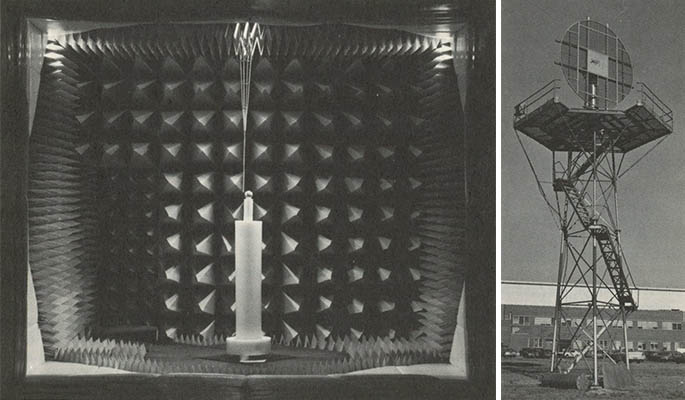
Prior to joining the department, Prof. Senior had been working on missile detection in England. By the 1960’s, his research turned to stealth technology, and a better anechoic chamber was needed. The new chamber was only 44 ft. long and built with a tapered design with thick materials on the walls to reduce the reflection of signals.
The chamber was built as part of a project called SURF to measure surface fields on missiles and aircraft. The original SURF project was supported by the U.S. Air Force from 1964-67 and then extended an additional three years by funding from other agencies another three years. The work of measuring surface fields, however, continued into the late 1990’s.
Measuring surface fields rather than trying to determine cross sections was a new approach to ultimately designing missiles and aircraft that had less chance of being detected. In order to avoid competition with Conductron Corp., the faculty turned their attention primarily to aircraft.
According to Senior, their recommendations helped determine the design of the first modern-looking stealth aircraft. The design was to be very thin that allowed for very little reflection. The cockpit and overall shape of the aircraft was curved for the same reason. The aircraft was also to be made of materials that would further reduce the cross section. “The first model of the stealth aircraft was measured by us,” recalled Senior, who added that the calculations he and his colleagues were doing to hide and detect aircraft were some of the first of their kind. Much of this research was classified.
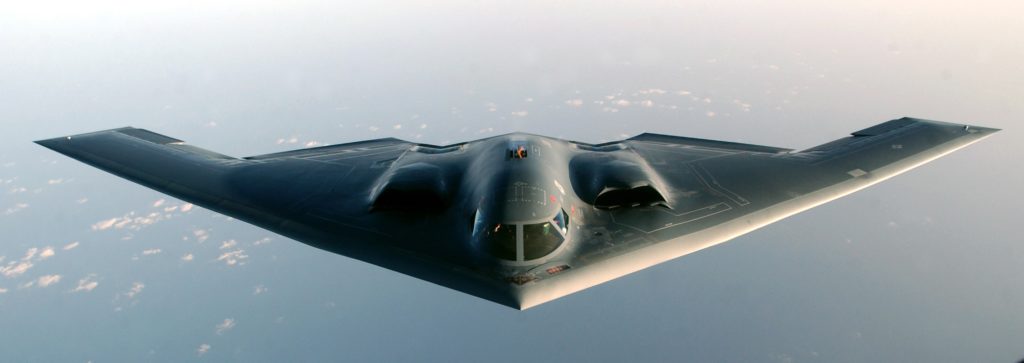
Prof. Senior recalled the early days at Willow Run when there was a security officer protecting the offices and labs. By the mid 1970’s, due in part to pushback from the University, there was very little classified research going on any more at the facility. Willow Run itself became the Environmental Research Institute of Michigan (ERIM) in 1972.
The 1969 book, Electromagnetic and Acoustic Scattering by Simple Shapes, by Piergiorgio L. Uslenghi, Thomas B. Senior, and J. J. Bowman was the culmination of research conducted by members of the RADLAB. Just a couple years later, the size of the RADLAB had reduced to approx. 30 researchers, about a third since the end of the SURF project.
When the researchers finally moved into the East Engineering Building in 1974, the numbers were down to 18 – small since the heyday of the RADLAB, but still sizable compared to the entire roster of EE faculty. It was the first time the faculty were located near the students. Prof. Senior was named Director of the RADLAB in 1975, and alumnus Dr. Valdis Liepa (BSE MSE PhD 1959 1960 1966) Assistant Director.
The next major research endeavor in the RADLAB had to do with alternative energy. “The oil shortages of the 1970s changed the energy picture for the U.S. and the world. It created an interest in alternative energy sources, paving the way for the re-entry of the wind turbine to generate electricity.” [Wind Energy Foundation]
Television stations became aware of this and became worried that the turbines would interrupt television reception. Beginning 1976, in a project funded by CBS Technology Laboratories, the RADLAB began to develop the environmental restrictions that were to be placed on large wind turbines. Back then, the turbines were made of metal and had a significant effect on TV reception. “We developed the formulas to tell you how strong will be the effect on television signals,” said Senior.
The research was funded for seven years (until gas prices finally went down), and the Radlab remained the premier source of all electromagnetic data for the environmental impact assessments required of wind turbine installations. Dr. Dipak Sengupta was a key researcher in this project, working with Prof. Senior.
In 1977, in anticipation of Willow Run being sold by the University, a new and improved anechoic chamber was built in the basement of the East Engineering Building. The facility was equipped with an advanced data acquisition and processing system that allowed data to be obtained from 110 to 4400 MHz. Senior recalled:
By 1983 it seemed that we had measured almost every aircraft of interest to the Air Force, some many times over. … [W]e continued to use the surface field facility for other studies such as the penetration of fields into cavities, the detection of lightning, and the impact of bridges on LORAN-C [a radio navigation system that preceded satellite-enabled GPS].
Over the years, Prof. Senior developed an international reputation for his work in scattering and electromagnetics. His primary research interests were the study of the diffraction and propagation of electromagnetic waves, with application to physical problems. After serving as either Associate Director or Director of the RADLAB for 25 years, he stepped down in 1987 to serve as Acting Chair of the department.
Space Physics Research Laboratory
William G. Dow founded the Space Physics Research Laboratory (SPRL) in 1946 to continue research on captured German V-2 rockets, an activity undertaken by several groups across the country immediately following the war. It was reportedly Dow who convinced the leaders in Washington to fund this area of research in order to explore near-space environments. The first research activity consisted of measurements of the earth’s upper atmosphere with instruments conceived and constructed by the Laboratory and flown on captured V-2 rockets.
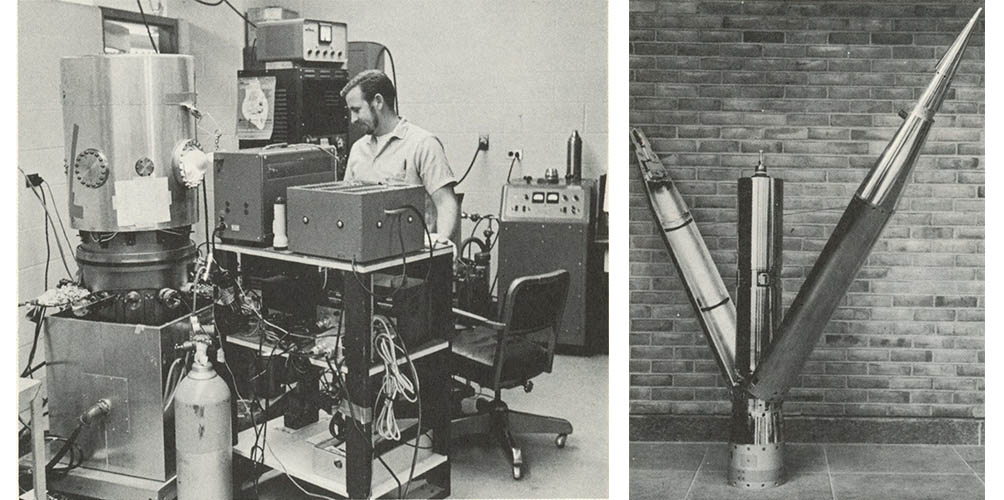
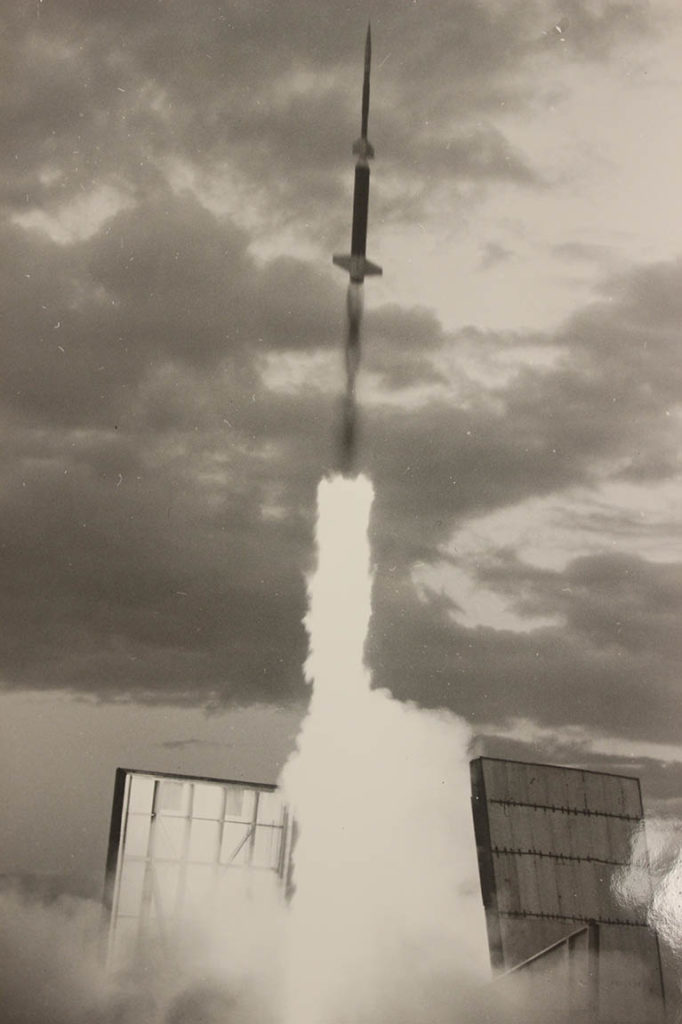
Prof. Nelson Spencer became director of the lab in 1951. He was a member of the Rocket and Satellite Research Panel, which planned the nation’s space program during the 1950’s. SPRL built about 15 rockets which were launched in 1957 and 1958.
Dow and Spencer developed a successful method of measuring air temperatures to an altitude of about fifty miles, and developed a new way to directly measure properties of the E layer of the ionosphere. Spencer left the University in 1960 to work with NASA as Chief of the Planetary Atmospheres Branch.
In recent decades, SPRL has been most closely associated with the Climate and Space Sciences Department, though individual ECE faculty have maintained strong ties with the lab, particularly former astronaut Anthony England and Brian Gilchrist. In 2015, Prof. Gilchrist was named Director of SPRL, charged with supporting the lab’s new future as a College-wide interdisciplinary research entity impacting robotics, autonomous vehicles, distributed sensor networks, and many other areas.
Rise of Computing (1940s – 1950’s)
The slide rule was the “computer” of choice for students and professional engineers for much of the 20th century – until the affordable pocket calculator of the 1970’s took its place. However, behind the scenes, important advancements were being made in the development of electronic computers in the mid to late 1940’s. WWII once again provided motivation for groundbreaking research – this time leading to the world’s first general-purpose electronic computer, called the ENIAC. One of the core applications for the ENIAC was to compute the artillery firing tables for the U.S. Army.
Prof. Arthur W. Burks worked on the ENIAC and was on hand to conduct the first public demonstrations of the computer in 1946, the same year he joined the University of Michigan. He graduated with a PhD in Philosophy from Michigan in 1937, and returned to that department.
Burks founded the Logic of Computers Group in 1949, the first research organization dedicated to computing at the University. He helped start the graduate program in Communication Sciences in 1957 and the Department of Computer and Communication Sciences (CCS) in 1967. The CCS department was later merged into the EECS Department. More about this early history is a story best told by the Computer Science and Engineering division of the department.
Two notable early researchers and educators of computers within the EE Department were Norman R. Scott and Harry H. Goode.
Prof. Scott, hired in 1951, taught the first electrical engineering course in computers, called “Seminars in Computer Technology” in 1952. He followed this up in 1954 with the course, “Analog and Digital Computer Technology.” He acquired computers for the instructional laboratories that he was developing, and became recognized nationally for his work on digital computer logic and design. Prof. Scott was responsible for much of the design work for the Michigan Instructional Computer (MIC) in 1955.
Prof. Goode was hired into the department in 1954. At the time he was also Director of the Willow Run Research Center. He directed the group that built the University’s first electronic digital computer, called the Michigan Digital Automatic Computer (MIDAC). The MIDAC was used primarily for defense work. Prior to his time at Michigan, he was an early leader of the simulation computers Whirlwind, Cyclone, Hurricane, and Typhoon.
Prof. Goode is known for formulating important principles of systems engineering and introducing the course, “Large Scale System Design.” He co-authored the book, System Engineering: An introduction to the design of large-scale systems, in 1957, which is part of the McGraw-Hill Series in Control Systems Engineering and considered one of the earliest books of its kind. He reportedly taught the first course in the country on this topic.
Goode was president of the National Joint Computer Committee, and the organizer of the group that came to be known as the American Federation of Information Processing Societies. Sadly, he died in a traffic accident in 1960. His legacy lives on through the Harry H. Goode Memorial Award for achievements in information processing, sponsored by the IEEE Computer Society.
Electrical and Computer Engineering would later play an important role in the development of more advanced computing systems and VLSI (very large scale integration), discussed later.
Synthetic Aperture Radar (SAR) and Optical Processing (1950’s)
Synthetic Aperture Radar (SAR) is used today on most jet fighters and several earth-orbiting satellites to image the earth from the sky. First proposed by a mathematician in 1951, researchers at Willow Run were among the first research groups involved in the development of SAR. They were part of Project Michigan, a program initiated in 1953 and sponsored by the Army, Navy, and Air Force. This team would accomplish the first successful focused airborne synthetic aperture radar.
During the early 1950’s, computers were in their infancy and could not handle the gigantic computing task that was required to process the radar data. Lou J. Cutrona and Wes E. Vivian, both faculty in the EE Department, decided to accomplish the task using optical processing. When it came time to build the radar system, Emmett Leith, a junior researcher, chose to work on the optical processor because he was the only one in the group of 16, aside from another newly hired engineer, who had taken any coursework in optics.
Within a couple years, Leith developed a completely new theory of SAR, based on physical optics. Leith stated, “this new way of describing SAR in combination with optical processing is what today would be called a holographic viewpoint.” Until it was proved, however, many scientists did not give the theory much credit.
The new radar system was ready to be tested in 1957. Eight flights yielded no images – which seemed to vindicate the critics of the new method and threaten continuation of the project. Flight nine, however, “produced some startling results,” recalled Leith. “The terrain was beautifully mapped. The Michigan SAR system became famous.” The new radar system allowed for high-quality mapping of enemy territory from a safe distance, penetrating even fog and darkness at longer distances than previously possible.
The Michigan group continued to improve and advance system resolution over the coming 15 years, so that by the mid 1970’s, it was possible to identify soil, water, vegetation, and ice, as well as military targets.
Practical Holography and Optics at Michigan (1960’s)
Prof. Leith’s work with SAR led to his discovery of wavefront reconstruction, and then of Dennis Gabor’s work in 1956. Gabor invented the idea for holography in the late 1940’s and early 1950’s, but was never able to get it to work. Now that the SAR research was cruising along, Leith decided to investigate optical holography in earnest in 1960 to see if he could succeed. He approached Dr. Juris Upatnieks, a scientist who had just joined the Willow Run lab in 1960, to get him interested in this new area.
The problem inherent in Gabor’s method seemed insurmountable, yet a moment of inspiration led to a unique approach, called carrier-frequency, or more popularly, off-axis holography. This groundbreaking work was published in 1962 in the Journal of the Optical Society of America. The basic problem was solved, yet further refinements and advances were needed before the technique would capture worldwide attention.
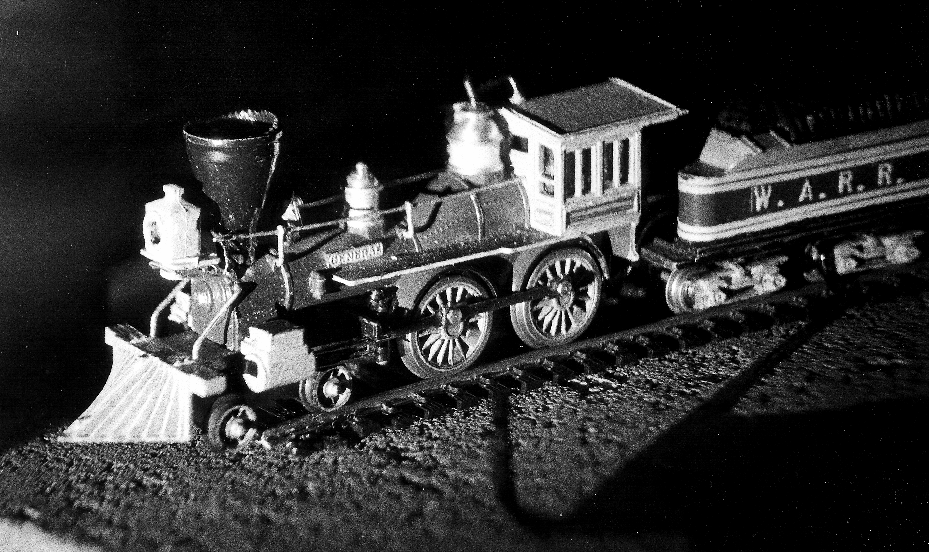

This attention occurred at the Spring 1964 meeting of the Optical Society of America in Washington, DC. As recalled by Stephen Benton in the book, The Art and Science of Holography, “Leith and Upatnieks gave a short oral paper on their 3D holograms, and invited the attendees to view a hologram in the hotel suite used by the Spectra-Physics company, who made most of the early holography-capable lasers. A line of optical scientists and engineers wound down the hallways of the hotel as they patiently waited to see the 3D images that were absolutely unprecedented in their realism and accuracy.”
The appearance of a crystal-clear 3-dimensional train completely transfixed the optical community, and led to press releases all over the world.
As affirmed by Gabor himself in his Nobel Prize lecture, the success of Leith and Upatnieks “was due not only to the laser, but to the long theoretical preparation of Emmett Leith, which started in 1955. This was unknown to me and to the world, because Leith, with his collaborators Cutrona, Palermo, Porcello, and Vivian applied his ideas first to the problem of the “side-looking radar” which at that time was classified… This was in fact two-dimensional holography with electro-magnetic waves… Their results were brilliant.”
Holography became a technology with sweeping applications in fields as varied as nuclear materials storage, credit card security, optical data storage, and medical imaging. Holography is widely considered one of the most promising developments in modern science. Leith earned more than 14 patents, including the first patent on holography, owned jointly with Upatnieks. For his accomplishment in turning the theory of holography into a practical reality, Leith received the National Medal of Science in 1979.
The study of optics underwent a period of resurgence as holography was applied to various engineering problems. Among the first modern courses in optics taught at Michigan were “Modern Optics” and “Coherent and Non-Coherent Optical Technology.” By 1970, new courses were being added regularly, and Optics had taken the place of related areas of Photometry and Illumination in the curriculum.
The Bioelectrical Sciences
Biomedical applications are at the heart of a wide range of current Electrical and Computer Engineering research. This area was built up between 1960 and 1970 through the hiring of several faculty with a biomedical focus, including David Anderson, Spencer BeMent, Dan Green, Clyde Owings, and William J. Williams. A Bioelectrical Sciences lab was initiated in 1968, directed by Prof. Williams, focused on electrophysiology and neurophysiology.

The graduate program in Bioengineering initiated in the EE Department in 1962. Prof. BeMent (BSE MSE EE ’60 ’62; PHD BIOENG ’67) was the first alumni of the program. He conducted research in the areas of information coding and transmission in neural systems, bioelectrical properties of tissue, and neuroprosthesis.
David Anderson became a leader in the development of neural probes in the 1980’s and 1990’s, in collaboration with Prof. Ken Wise. Anderson recalled that, “In the early ’70s there was only one company in the U.S. that had more than $500 million in gross sales and was primarily a bioengineering company – Medtronic in Minneapolis. So these students couldn’t assume they’d conduct their research in a company like most engineers did.” This was brand new territory.
Charles Cain (PHD EE ’72) was advised by Prof. Williams. Cain later became Director of the graduate program in Bioengineering in 1989, and the first Chair of the Biomedical Engineering Department in 1996. Cain recruited Matthew O’Donnell to Michigan, who was hired into the EECS Department in 1990. He became the second Chair of the Biomedical Engineering department.
Prof. Williams was internationally recognized for his contributions to the development and application of signal processing in biomedical engineering and biology. His methods and algorithms have been used to study such diverse phenomena as whale sounds, epileptic seizures, gear noise, and machine tool chatter in manufacturing operations.
Prof. Janice Jenkins joined the faculty in 1980, and established a flourishing program in the design of computer algorithms for detecting abnormal heart rhythms, specifically for implantable cardioverter/defibrillators. She was the first female faculty member hired in the department.
With the establishment of the Biomedical Engineering Department in 1996, there was no longer a need for a specific lab in this area. However, research with medical applications can be found in most every major area within ECE even today.
Changing Curriculum
In 1969, the number of required undergraduate credit hours for graduation was reduced from 138 to 128 hours. Required courses included: Physics (11 ch), Math (16 ch), humanities (24 ch), freshman course in digital computing and graphic communication, and the remaining credits in a variety of ECE areas.
Courses were categorized into the following three tracks of study: Electronics and Design; Electrical Science (Radiation, optics, quantum electronics and devices); and Computer, Information and Control Engineering. New courses were being developed in the areas of computer engineering, communication systems, and power systems. In 1969, space was created for a new Integrated Circuits Laboratory.
In 1970, there were more than 100 courses offered in the EE department, taught by 60 faculty. The department granted 111 BSE EE degrees, 74 MS degrees, and 26 PHD degrees. By the end of the 1970’s, the number of bachelor’s degrees awarded had doubled; a third of them were in computers.
1970’s – 1980’s: Decades of Transformation
The New Program in Computer Engineering
Computer research and education was splintered across the university and even within the College of Engineering since the 1950’s. Groups were developing their own computing systems and working on different aspects of computer design within the department, in the College of LS&A, as well as at Willow Run and later MERIT.
In the late 1960’s, faculty in the College of Engineering began to plan for a computer engineering degree within the college. This was approved in late 1971, in time for students to take courses in that major the next term, Winter 1972. Paul Heininger (BSE CE 1974) was a student during that time, and was actively campaigning for the new degree. He recalled:
There was one new class in the curriculum which I think was titled: “Algebraic Foundations of Computer Engineering”. It was a discrete mathematics course. It was first offered in Winter 1972. Profess John Meyer taught it the first time. One of the students was Professor Keki Irani so he could teach it the next semester. There were a large number of students since anyone who wanted to graduate with the BSE (Computer Engineering) in April / May 1972 had to take it.
The former Electrical Engineering Department also changed its name to the Department of Electrical and Computer Engineering in 1971, and offered this new undergraduate program in computer engineering. It was one of the first such programs in the country.
However, the CICE graduate program and the Department of Computer and Communication Science (founded in 1967) continued to compete for students at the graduate and undergraduate levels.
In 1975, when Prof. Haddad became Chair following Prof. Rowe’s departure, he organized the department into 2 divisions, Electrical Engineering and Computer & Information Systems.
The 1970’s were the worst decade for the department, and perhaps the entire College, since the Great Depression. The College ranked last in funding from the University, federal research support was declining, and the University cut its instructional budget by almost one-third. This was the continuation of a trend begun the previous decade, when the University preferred to focus on Great Society themes of social justice while defunding science and technology. During this decade, the College lost 24% of its faculty, while enrollment grew by 44%.
Within the department, Prof. Haddad saw the additional problems of a department spread thin because of faculty involvement with the CICE and bioengineering programs. Student enrollment was hitting new highs by the late 1970’s and early 1980’s, with no ability to hire additional faculty to teach them. Prof. Haddad was also concerned with building up the computer engineering program with extremely limited resources to hire additional faculty.
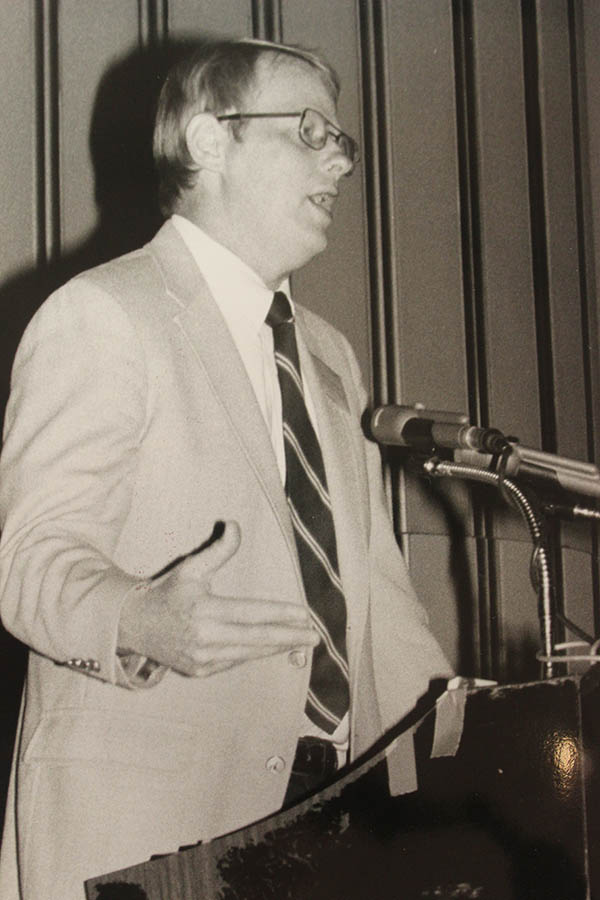
Dramatic changes began to happen after the appointment of Jim Duderstadt as Dean of the College of Engineering in 1981. Among the many changes he instituted across the entire College, he allowed the department chairs to hire many new faculty, and raised standards and expectations for faculty research output. He also orchestrated funds for a new EECS Building. Duderstadt was succeeded in 1986 by Chuck Vest, another great leader.
When Haddad asked for eight faculty slots from the new Dean that first year, hoping to get 1 or 2, he was nearly blown over when he got approval for all eight – and that wasn’t a one-time deal. During the Duderstadt-Vest era (1981-88), Haddad hired 69 faculty, more than three times the number of faculty hired in the previous decade. “That means we had to interview about 150 people in those years,” said Prof. Haddad, “and I personally had breakfast and dinner with each and every one of them. I gained 40 pounds.”
Those hires were fairly representative of the current field of Electrical and Computer Engineering, with faculty specializing in the following areas: VLSI, Remote Sensing, Antennas, Optoelectronics, Solid-State Devices and Electronics, Nanotechnology, Computer Architecture, Quantum Computing, Lasers (materials, spectroscopy, physics), Wireless Communications, Signal Processing (and Data Science), Semiconductors, Control Systems, Nonlinear Optics, Computer Aided Design, Bioengineering, Integrated Circuits, Robotics, Information Theory, Computational Electromagnetics, Materials, Ultrafast Optics, and Micro Electro Mechanical Systems (MEMS). Many computer science fields were also represented.
This swath of hiring included many future leaders of the department whose work has made an enormous impact on their respective areas, as will be described later on in more detail. Another key contribution of Dean Duderstadt was securing funds for faculty lab equipment through the Michigan Research Excellence Fund (REF), funded by the State of Michigan in the mid 1980’s.
The REF brought $10M to the University for research in microelectronics, robotics, and materials research. A good deal of these funds went to research, equipment, and facilities in the department, including the Solid-State Electronics Laboratory and the new EECS Building. The REF was part of the State’s efforts to stabilize the economy in light of the decline of the auto industry. The Governor and others saw high technology as the best path to economic stability.
The Dean’s proposal called for an emphasis on the “exciting new field of integrated optoelectronics.” This was quite a visionary initiative, and played directly into the strengths of Prof. Pallab Bhattacharya, hired in 1984, whose collaboration with Jasprit Singh (hired 1985) and Ted Norris (hired 1991) opened up an entire new field of quantum optoelectronics.
The influx of new faculty combined with vastly upgraded facilities occurred in the nick of time for the Department to take advantage of opportunities in sponsored research. In the 1980’s, the government began to support large research centers within universities. One of the first to receive a DoD-funded University Research Initiatives (URI) was George Haddad, through his Center for High-Frequency Microelectronics (1986-2001). This was followed up by the Center for Integrated Sensors and Systems (1987-2000, directed by Ken Wise), the Center for Space Terahertz Technology (1988-1998, directed by Fawwaz Ulaby), and the Center for Ultrafast Optical Science (1991-2001, directed by Gérard Mourou).
Those programs were followed by governmentally-sponsored Multidisciplinary University Research Initiative (MURI) programs, initiated in the late 1980’s to support basic research spanning science and engineering disciplines.
Prof. Haddad directed the Center for High Frequency Microelectronics after he stepped down as Chair for the first time in 1986, and several MURI projects after he stepped down the second time in 1997. During his nearly continuous time as Chair from 1975-1997, research funding grew from $2M to $35.8M in annual research expenditures, faculty for the entire EECS department grew from 44 to 89, PhD’s graduated went from 7 to 66, graduate student enrollment grew from 212 to 650, and undergraduate student enrollment grew from 708 to 772. These numbers are for the entire EECS department. The department was ranked #5 by U.S. News & World Report. Prof. Haddad left a remarkable legacy of achievement and leadership in research, teaching, service and administration that spans 42 years as a faculty member, and 19 years as department chair. In 2012, he became Program Director for Circuits, Communications and Sensing Systems in the Division of Electrical, Communications and Cyber Systems at NSF.
1983 – Defense Research Spurs Student Sit-ins
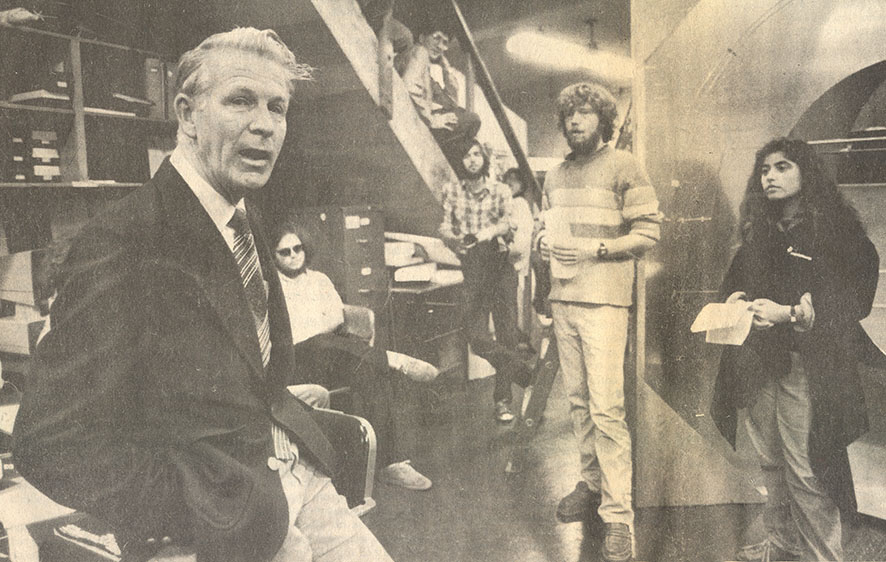
By the 1980’s, the amount of military research being conducted by the faculty became a concern for certain members of the student body. With ECE’s emphasis on research, largely funded by the government, certain ECE faculty (George Haddad, Tom Senior, and Ted Birdsall) were targeted by the students in official protests.

A group of students called the Progressive Student Network (PSN) invaded Prof. Senior’s lab in the basement of East Engineering on November 7, 1983 and staged a 48-hour sit-in.
In protest of the PSN, the Nuclear Saints of America (NSA) was formed by student researchers who vowed to continue on with defense-funded research.
In March of the following year, the PSN, consisting of nine women and two men, attempted a sit-in in Prof. Haddad’s lab. Prof. Haddad decided enough was enough, and called the Ann Arbor police to remove them, saying, “They were interfering with the rights of my researchers and students to do work in the lab. We were very patient the first time but we can’t go on like this.”
Members of Students for a Democratic Society published anti-war and anti-military research comics in their brochure, “Strung Out: A Report on the Relationship Between the University of Michigan and the Military,” 1970, Labadie Special Collections, University of Michigan.
Despite the targeting of the department by the protestors, there was, in fact, no nuclear research and no direct weapons research being conducted in ECE. However, there were indirect links – as might be expected in the development of new technology funded by the Department of Defense. For example, Prof. Haddad had been working on solid-state devices known as IMPATTs, which unknown to him were being incorporated into combat missiles. “But that same research has civilian applications,” said Haddad in a published interview, stressing his research was at the device level, and could therefore be incorporated into a number of systems.
Two years later, in 1986, Prof. Haddad’s lab was in the news again. He received a large grant from the U.S. Army which established the Center for High Frequency Microelectronics (CHFM). This prompted another outcry from students who were opposed to large sums of money being spent on defense. While some of the students did not appreciate this new grant, it was cause for great celebration as it alone nearly doubled the research funding for the entire University. The funds supported study of super-speed computers and other advanced electronic devices, with the goal of developing electronic devices capable of vastly improved processing and information transmition.
The protesting ceased when engineering moved to North Campus later that year.
 MENU
MENU 
